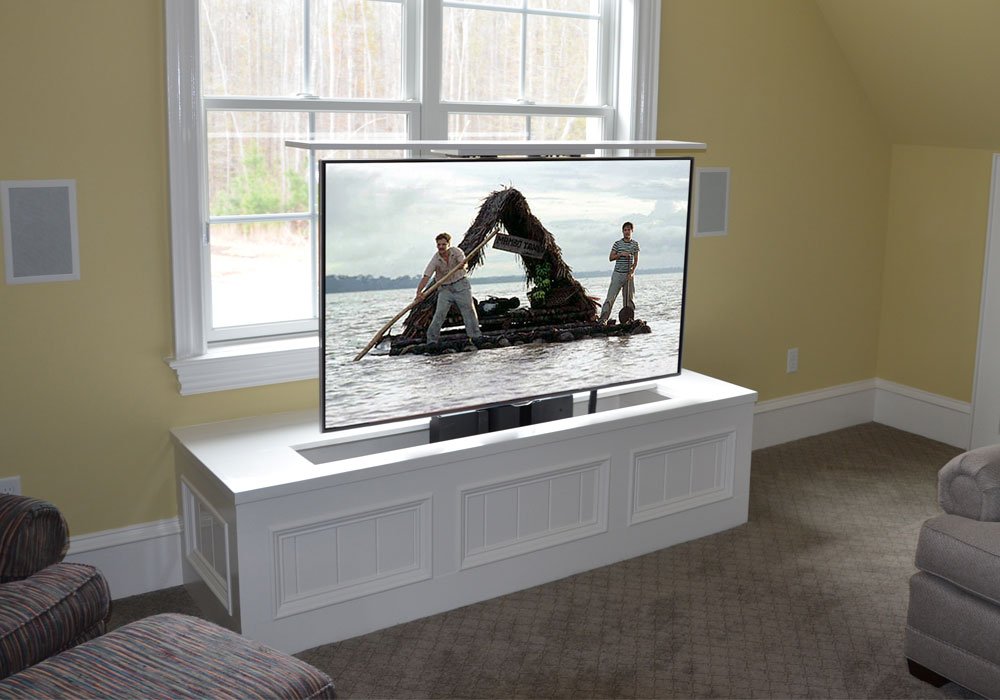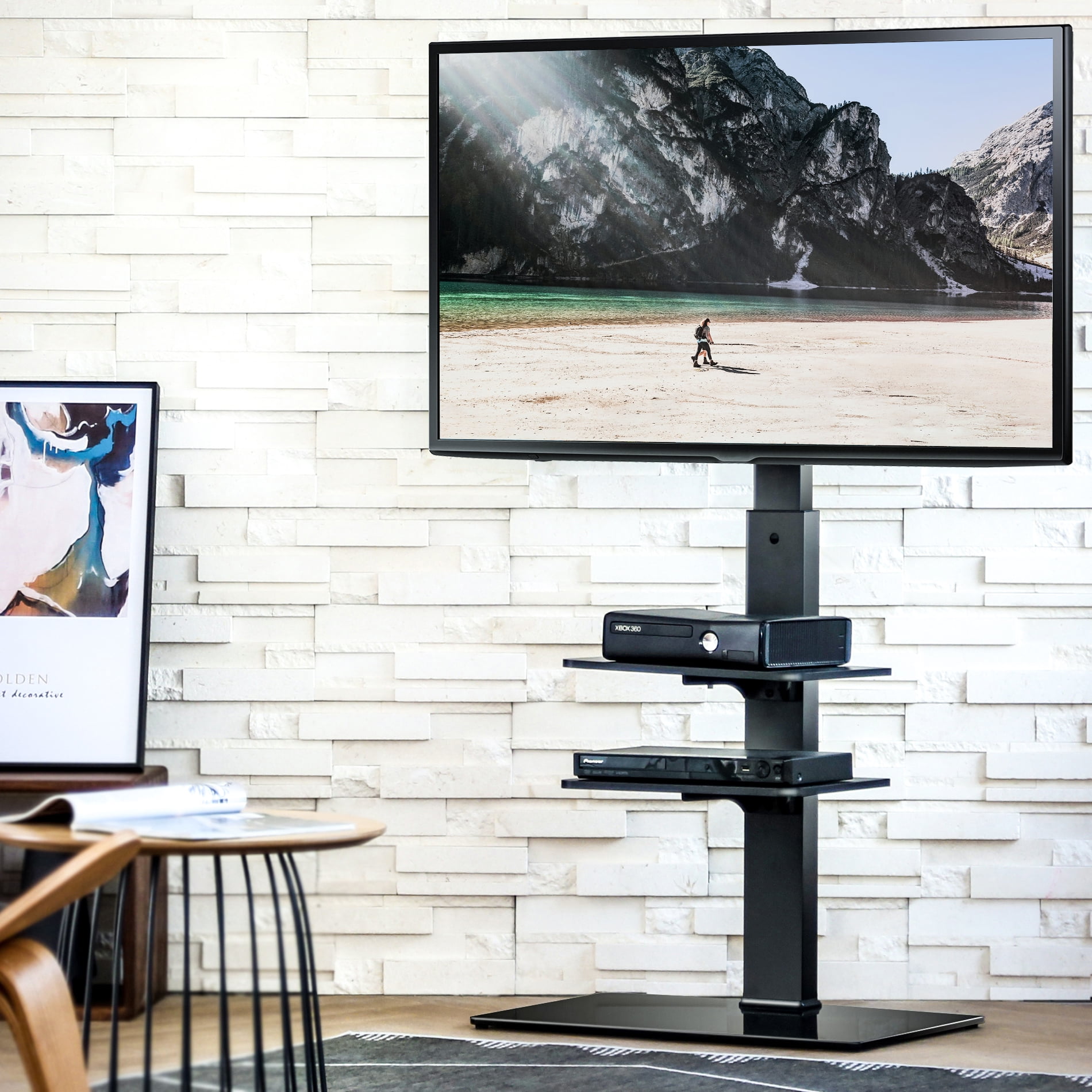Remember that time you were a kid, sprawled on the floor with your nose practically touching the TV screen, completely absorbed in your favorite cartoon? Maybe you were even building a pillow fort around the television, creating your own private viewing sanctuary. While those days might seem like a distant memory, the question of whether or not you can put your TV on the floor still pops up from time to time. And it’s a valid one! Sure, a TV stand or entertainment center looks great, but sometimes you just want to go for a more relaxed vibe, and placing the TV directly on the floor might seem like the perfect option. But before you go rearranging your living room, there are a few things to consider.

Image: www.tvlift.com
Putting a TV on the floor can be a great way to create a cozy and casual atmosphere. It can also be a practical solution if you have limited space or want to avoid the expense of a dedicated TV stand. However, there are also some potential drawbacks to consider, such as safety concerns and potential damage to your TV. In this article, we’ll dive into the pros and cons of putting your TV on the floor, explore the potential safety risks, and provide tips for ensuring a safe and enjoyable viewing experience.
The Advantages of Floor-Level TV Viewing
Let’s face it, there’s a certain charm to having your TV on the floor. It can give your living room an undeniable “chill” factor, especially if you’re aiming for a more laid-back, bohemian aesthetic. And, it’s not just about appearances. Placing your TV on the floor can have some practical advantages as well.
Space Optimization and Flexibility
If you have a small living room or simply prefer a less cluttered look, placing your TV on the floor can help create a more spacious feel. It eliminates the need for a bulky stand or entertainment center, freeing up valuable floor space. The flexibility of floor placement also allows for a more dynamic home theater setup, letting you adjust the TV’s position easily to suit your viewing preferences. For example, you can easily shift the TV around to accommodate different seating arrangements for movie nights with friends or family gatherings.
Aesthetic Appeal
There’s a distinct aesthetic appeal to a low-slung TV setup, especially for modern minimalist décor. It can enhance the overall ambiance of the room, creating a streamlined and uncluttered visual experience. Imagine a sleek TV nestled on a plush rug, surrounded by stylish furniture. It definitely adds a certain sophistication to your space. Furthermore, you have the creative freedom to personalize the look even further with decorative accents around the TV, such as plants, artwork, or unique objects, creating a visually engaging focal point in your room.

Image: www.secondharvestmadison.org
Ergonomics and Viewing Comfort
Placing your TV on the floor might seem like it would be bad for your neck or back, but that’s not necessarily the case. In fact, many people find it more comfortable to watch TV from a lower position, especially if they prefer to sit on the floor or a beanbag chair. It can even help reduce eye strain and fatigue, as you’re not constantly looking up at a screen. However, it’s important to choose a comfortable seating position and consider the height of the TV to ensure a comfortable viewing experience. Too low, and you might find yourself straining your neck, while too high can lead to discomfort and eye strain. But, with proper planning and consideration, a floor-level setup can be just as ergonomic as a traditional raised TV arrangement.
Considerations and Potential Risks
While floor-level TV placement has its advantages, there are also some potential drawbacks and risks to consider. It’s crucial to be aware of these factors to maximize safety and ensure the longevity of your valuable electronics.
Safety for Children and Pets
The greatest concern with a TV on the floor is the potential for accidents, especially with young children and pets. Little ones might be tempted to climb on the TV, potentially causing damage or injury, while curious pets could easily knock it over, leading to a costly screen replacement. If you have curious children or playful pets, it’s best to reconsider floor placement and opt for a more secure, elevated position.
Dust and Debris Accumulation
A TV on the floor is much more susceptible to dust and debris than one placed on a stand. This could not only affect the aesthetic appeal of your TV but also contribute to its degradation over time. The accumulation of dust and debris can lead to overheating issues, reducing the lifespan of your electronics. To minimize these concerns, consider using a dust cover or regularly cleaning your TV to maintain its optimal performance and longevity.
Accessibility and Viewing Angles
While floor placement can offer flexibility, it can also make it difficult to access the TV’s ports and connections. The low position might also create awkward viewing angles depending on your seating arrangement and the size of your screen. For optimum comfort and visibility, ensure the TV is positioned at a comfortable height and angle that allows for an enjoyable viewing experience for all those in the room.
Stability and Security
A free-standing TV on the floor can be prone to instability, especially on uneven surfaces or in areas with high traffic. This can be a particular issue in homes with kids and pets, as even a slight bump can send the TV tumbling. To make sure your TV is stable and secure, place a non-slip mat underneath it and avoid placing it in areas where it could easily be knocked over. Additionally, consider using a TV wall mount, which provides a more secure and stable placement.
Tips for Safe and Enjoyable Floor-Level TV Viewing
Here are some tips to help you navigate the floor-level TV placement landscape, ensuring a safe and enjoyable viewing experience for you and your family:
Choose the Right Location
Carefully select a spot for your TV that is not only aesthetically pleasing but also secure and accessible. Avoid placing it in high-traffic areas, near furniture that can easily bump into it, or in direct sunlight. Opt for a flat and level surface with minimal obstacles for a stable base.
Consider the Size of Your TV
The size of your TV plays a role in its stability. Larger TVs are naturally heavier and more prone to tipping. If you’re going with a floor-level setup, consider a smaller TV or explore secure mounting options if you have a large screen. Remember, your primary goal is to prioritize safety.
Use a Non-Slip Mat
A non-slip mat placed under the TV can help prevent it from sliding and potentially falling. This is especially important if you have hardwood or tiled floors, which can create a slippery surface.
Monitor for Wear and Tear
Regularly inspect your TV for signs of wear and tear, including scratches, dents, or loose connections. Immediate attention to any issues can prevent further damage and ensure your TV remains in good working order.
Frequently Asked Questions
To provide full clarity on the topic of TV placement, here are some frequently asked questions:
Can I put my TV on a carpet?
While possible, placing your TV directly on a carpet, especially a high-pile one, is generally not recommended. The pile can potentially obstruct ventilation, and the carpet can easily shift, creating an unstable base. If you opt for carpet placement, use a non-slip mat to secure the TV and ensure adequate ventilation.
Is it OK to put my TV on a hard floor?
Placing your TV on a hard floor, such as tile or hardwood, is generally safe, especially if you use a non-slip mat to prevent it from sliding. However, ensure the floor is level to prevent instability and that the TV is positioned away from any potential obstructions or high-traffic areas.
Can I use a TV stand instead of placing it on the floor?
Yes, using a TV stand is a more conventional and often safer option. It provides a dedicated and stable platform for your TV, offering greater protection against falls and ensuring proper ventilation.
What if my TV is too heavy for a floor placement?
If your TV is particularly heavy, it’s generally best to use a stand or mount it on the wall. Such solutions provide greater stability and reduce the risk of accidents. If you’re unsure, consult the TV’s manual for recommended weight limits and safety guidelines.
Conclusion
So, can you put your TV on the floor? The answer, like many things in life, is a qualified “maybe.” While it can create a unique and stylish look, it’s important to prioritize safety by considering the potential risks and implementing strategies to mitigate them. Take your time, assess the situation, and choose a placement that works best for your home and your family. Ultimately, the decision is yours. Do you prioritize the cozy, casual vibe of a floor-level TV or the added security of a dedicated stand or a wall mount? Whether you choose to keep your TV on the floor or opt for a more traditional setup, ensuring a safe and enjoyable viewing experience is paramount.
Can I Put My Tv On The Floor
Are you interested in learning more about TV placement tips, other interior design trends, or tips on choosing the right TV for your home?






